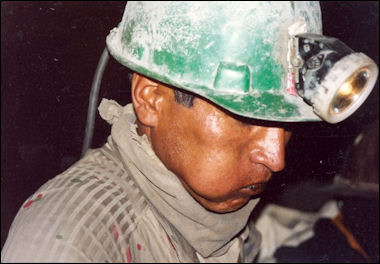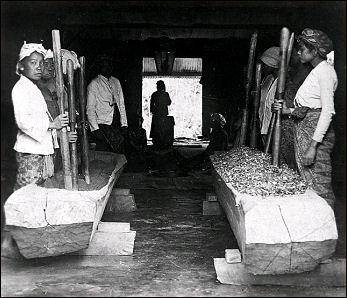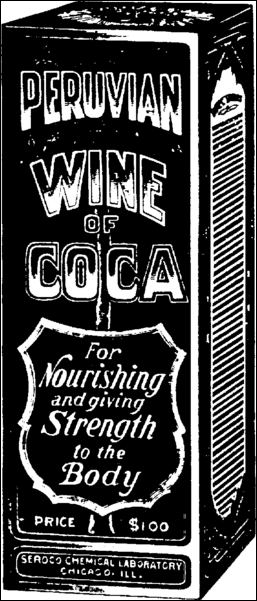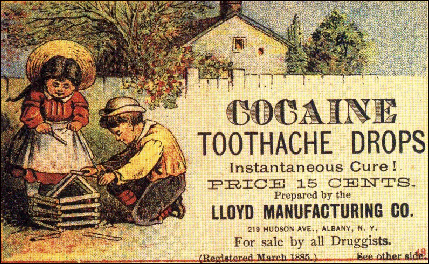HISTORY OF COCA

coca chewer from A.D. 850-1500
People have been chewing coca leaves in the Andean highlands for millennia. The oldest concrete evidence of coca leaf use is a 3500-year-old statue in a museum in Ecuador with a figure with a "characteristic chewers bulge in his left check." The Incas used the drug as did the Moche, and both cultures glorified it in their artwork. [Source: Peter White, National Geographic, January 1989]
Traces of coca leaves with the the alkaline mineral lime, dated to 8,000 year ago, found in northern Peru, is the earliest evidence of coca chewing. Other evidence of coca use includes: 1) traces found in mummies in northern Chile dated to 3000 years ago; 2) use by the Valdivian culture, circa 3000 BC; 3) an unbroken record of coca leaf use by succeeding cultural groups on the coast of Ecuador until European arrival; 4) lime containers found in the north coast of Peru in the Huaca Prieta and the Jetetepeque river valley. dated to around 2000 B.C.
Indians have traditionally chewed coca to feel warm in the cold, to get an energy boost and to dampen their hungers. Wads of coca leaves are still placed on the forehead to relieve headaches and coca tea is consumed to relieve the symptoms of altitude sickness. Leaves have also traditionally been given to babies to make them stop crying. Before the arrival of Europeans, people of the Andes made ritual offerings using the “hoja sagrada” (“sacred leaf”) .There is an altar in the temple of Mother Earth at Macchu Pichu where coca used to be ceremonially burned in a ceramic dish. After the Incan empire declined, coca became easier for ordinary people to obtain.
See Separate Articles:COCAINE: USE, EFFECTS, DANGERS AND HOW IT WORKS factsanddetails.com ; CULTIVATION OF COCA (THE SOURCE OF COCAINE) factsanddetails.com ; COCAINE PRODUCTION: JUNGLE LABS, WORKERS AND COCA PASTE factsanddetails.com ; GLOBAL COCAINE TRADE factsanddetails.com
Coca Chewing
The word for consuming coca leaves in Spanish is “ coquear” — to coca. To take coca you stick a big wad of leaves between your cheek and gum, as if you were chewing tobacco, and throw in a little bit of lime. The lime can come in the form of a black stone or a white powder and it is what draws out the minute amounts of the alkaloid cocaine from the leaves. Raw coca leaves, chewed or consumed as tea, are rich in minerals (calcium, potassium, phosphorus), vitamins (B1, B2, C, and E) and protein and fiber.
Typical coca consumption varies between 20 and 60 grams per day, and contemporary methods of chewing it are believed to be unchanged since ancient times. Typically, coca is kept in a woven bag. In some places a tiny amount of ashes of the quinoa plant are added to the coca leaves to soften the the astringent flavor and activates the alkaloids. In the old days, a wooden stick or spatula was used to carefully add lime into a coca leaf quid without touching inside of the mouth with the corrosive lime. The alkali (lime) component has traditionally been kept in a gourd and was made by burning limestone, quinoa stalks, or the bark from certain trees. In the Sierra Nevada de Santa Marta, on the Caribbean Coast of Colombia, the Kogi, Arhuaco, and Wiwa people use special device called a poporo when consuming coca. It consists of “womb” and phallic stick. The movements of the stick in the poporo symbolize sexual intercourse. The poporo is used in initiations to manhood. When a boy reaches marriageable age, his mother instructs him in the use of the coca. This rite is supervised by a traditional priest-chief. [Source: Wikipedia]

Incan god associated with coca You don't actually chew the leaves, you just let them sit there, and the cocaine is absorbed through the stomach and the mouth's mucous membranes. A coca chewer told Luis Marden of National Geographic, "It gives me strength to work, and I don't feel cold, hungry, or sleepy. besides, it tastes good." . Chewed with bits of “ alkaline llipta” , solidifies the ash of quinua stalks. Marden said, "my tongue felt twice its size. My heart faster...But the most curious effect appeared when I rinsed my mouth: the cold water felt burning hot." [Source: Luis Marden, National Geographic, February 1971]
Archaeological evidence indicates widespread chewing of coca leaves during the Moche period, beginning at least the A.D. 6th century, and the subsequent Inca period. This evidence includes, on mummies found with a supply of coca leaves, pottery depicting the characteristic cheek bulge of a coca chewer, spatulas for extracting lime, and containers for coca leaves and lime made from precious metal and featuring figuress, and gold representations of coca in special gardens of the Inca in Cuzco.
Coca chewing may originally have been limited to the eastern Andes before its was introducted to the Incas. The plant was viewed as having a divine origin, and thus its cultivation was controlled by a state monopoly and its use restricted to noble, the upper classes and favored public workers, skilled orators and members, the army by the rule of the Topa Inca (1471–1493).
Coca Use by the Incas
Spanish documents indicate that coca was a very important part Inca culture. Coca was: 1) used in Inca feasts and religious rituals; 2) given to workers by kings as a reward and to make them work harder; and 3) used to barter for valued goods. Coca was so important to the Inca that they colonized areas with tropical rain forests ideal for growing near their capital in Cuzco so that they could have a reliable coca supply. [Source: Wikipedia]
Coca was an essential part of the Inca mit'a labor tax system in which all able-bodied men in the Inca empire were required to do a military service or provided labor to state. Mit'a laborers, soldiers, and others chewed coca to alleviate hunger and thirst while they were working and fighting. The monumental construction projects of the Inca and the successful expansion of the Inca empire through conquest has been partly credited to coca.. By chewing coca, laborers and soldiers were able to work harder and for longer periods. Some historians believe that coca and chicha (fermented corn beer) made it possible for the Incas to move large stones in order to create architectural masterpieces, especially ones of monolithic construction such as Sacsayhuaman.

Bolivian miner chewing coca Spanish chroniclers that wrote about the importance of coca in their spirituality include Pedro Sarmiento de Gamboa, Father Bernabé Cobo, and Juan de Ulloa Mogollón. They considered coca to be the highest form of plant offering that the Incas made and noted how the Incas left leave coca leaves at important locations throughout the empire. Coca leaves were placed in the mouths of mummies, who also carried coca leaves. Mummies were an important part of Inca sacred life. Mummies of Inca emperors were valued for their wisdom and often consulted for important matters long after the body had deteriorated. Humans who were sacrificed also had bags of coca leaves. Coca was also used in divination. Ritual priests burned a mixture of coca and llama fat and predicted the future based on the appearance of the flame.
Coca Use in 16th Century Peru
In the 16th century Pedro Cieza de León wrote: In all parts of the Indies through which I have travelled I have observed that the natives take great delight in having herbs or roots in their mouths. Thus, in the district of the city of Antioquia, some of the people go about with a small leaf in their mouths, and in the province of Arma they chew another leaf. In the districts of Quinbaya and Anzerma they cut small twigs from a young green tree, which they rub against their teeth without ceasing. In most of the villages subject to the cities of Cali and Popayan they go about with small coca leaves in their mouths, to which they apply a mixture, which they carry in a calabash, made from a certain earth-like lime. Throughout Peru the Indians carry this coca in their mouths, and from morning until they lie down to sleep, they never take it out. [Source: The travels of Pedro de Cieza de Léon, A.D. 1532-50, Chapter XCVI: How the Indians carry herbs or roots in their mouths, and concerning the herb called coca, which they raise in many parts of this kingdom]
When I asked some of these Indians why they carried these leaves in their mouths (which they do not eat, but merely hold between their teeth), they replied that it prevents them from feeling hungry, and gives them great vigour and strength. I believe that it has some such effect, although, perhaps, it is a custom only suited for people like these Indians. They sow this coca in the forests of the Andes, from Guamanga to the town of Plata. The trees are small, and they cultivate them with great care, that they may yield the leaf called coca. They put the leaves in the sun, and afterwards pack them in long narrow bags, containing a little more than an arroba each.
This coca was so highly valued in Peru in the years 1548, 1549, 1550, and 1551, that there was not a root nor anything gathered from a tree, except spice, which was in such estimation. In those years they valued the repartimientos of Cuzco, La Paz, and Plata at eighty thousand dollars, more or less, all arising from this coca. Coca was taken to the mines of Potosi for sale, and the planting of the trees and picking of the leaves was carried on to such an extent, that coca is not now worth so much, but it will never cease to be valuable. There are some persons in Spain who are rich from the produce of this coca, having traded with it, sold and re-sold it in the Indian markets.
History of Coca Use by Europeans

coca production in colonial Java The Spanish issued a decree recognizing the importance of coca to the well-being of the Andean Indians but discouraged its use in religious rituals. It is believed the Spanish encouraged use of coca so that workers could work hard even when food was in short supply. After the Spanish initially failed to repress coca chewing among the Andean highlanders in the 16th century they turned to selling the leaf and made a fortune. On coca, a 16th century Spanish doctor wrote "the use of these little Bawles done take the hunger and thirst away from them." The Spanish gave coca to conscripted Indians working in the mines and plantations.
Coca was first introduced to Europe in the 16th century, but did not become popular until the mid-19th century, with the publication of an influential paper by Dr. Paolo Mantegazza praising its stimulating effects on cognition. This led to the invention of coca wine and the first production of pure cocaine. [Source: Wikipedia]
Vin Mariani was the best-known brand of coca wine. It and other coca-containing preparations were widely sold as patent medicines and tonics, with claims of a wide variety of health benefits. The original version of Coca-Cola was one of these. These products became illegal in most countries in the early 20th century, after the addictive nature of cocaine was widely recognized.
In the early 20th century, the Dutch colony of Java became a leading exporter of coca leaf. By 1912 shipments to Amsterdam, where the leaves were processed into cocaine, reached 1000 tons, overtaking the Peruvian export market. Apart from the years of the First World War, Java remained a greater exporter of coca than Peru until the end of the 1920s. Other colonial powers also tried to grow coca (including the British in India), but with the exception of the Japanese in Formosa (Taiwan), these were relatively unsuccessful.
In the 2000s, the governments of several South American countries, such as Peru, Bolivia and Venezuela, have defended and championed the traditional use of coca, as well as the modern uses of the leaf and its extracts in household products such as teas and toothpaste. The coca plant was also the inspiration for Bolivia's Coca Museum.
Andean Indians and Coca

Peruvian Wine of Coca Indians up and down the Andes chew coca almost all day, every day. Big bagfuls of coca leaves are sold almost everywhere in the highlands. Some Indians like to chew coca with small amounts of ash. Powdered lime from the ashes of roasted snail shells is sucked in through a stick. Many Andean Indians carry a gourd with crushed sea shell and periodically dip a stick in it and then in their mouths.
Upper class Peruvians look down on the mestizo coca chewers as peasants. One upper class man who hires peasants as laborers told National Geographic : "They believe it makes them strong. I think that's nonsense, but if you don't give them coca they keep yawning, turn melancholy, and want to go home. They'd rather have coca than food." [Source: Peter White, National Geographic, January 1989]
Men on road building crews, who spend their day breaking rocks with 25-pound sledgehammers, get a handful of leaves and a shot of sugarcane liquor when they start work in the morning. They'll get four more allotments during the day. A supervisor told National Geographic they won't take the job unless coca and liquor are given. Laborers doing other menial jobs work under the same terms. The only thing the workers bring is their own supply of lime.
Coca has traditionally been used as a stimulant and way of overcoming hunger, fatigue and thirst. It is considered particularly effective against altitude sickness and has been used as an anesthetic and analgesic to alleviate the pain of rheumatism, headaches and wounds. Its high calcium content explains why it has been used for bone fractures. Because coca constricts blood vessels, it was also used to stop bleeding. Coca seeds have been employed to stop nosebleeds. Indigenous people have also traditionally used coca as a treatment for ulcers, asthma and malaria, to improve digestion, to guard against bowel laxity, and as an aphrodisiac, Coca has been credited with improving longevity. Modern studies have supported some of these these medical claims and applications. [Source: Wikipedia]
Coca Rituals
Andean people chew coca at weddings and funerals and before young men go of to do their military service. One anthropologist told National Geographic, "For the people of the Andes it is essential to come together and chew coca before praying, because if you do not, God will not hear you.” Coca growers sometimes perform a rite in which they pick three leaves from one plant, hold them in the direction of a sacred mountain and blows on the leaves while chanting the name of the mountain spirit.
Coca has also been an essential part of the religious and ritual life of Andean peoples in Peru, Chile, Bolivia, Ecuador, Colombia and northwest Argentina since pre-Inca times and continues today. Coca leaf offerings are presented to apus (mountains), Inti (the sun), and Pachamama (the earth). Coca leaves are also often read to predict the future in a way not unlike the reading tea leaves. There are many traditional beliefs about coca. For example, miners of Cerro de Pasco believe that chewed coca thrown on veins of ore. Softens them up. Coca use in shamanic rituals is well documented in area where the coca plant have traditionally been cultivated. For example, the Tayronas of Colombia's Sierra Nevada de Santa Marta have traditionally chewed coca before engaging in long periods of meditation and prayer. [Source: Wikipedia]
Peter White wrote in National Geographic: different kinds of leaves have different purposes: "to put into the foundation of a new house; for help in matters of health, business of love. For magic white or black, good or bad." Folk herbalists pick them out and place leaves in groups of three for special cures. Many Indians believe that coca posses magical powers.
History of Cocaine

Cocaine for kids Cocaine was isolated in an impure form in 1844. In 1862, Albert Niemann. a German chemist at the University of Göttingen became the first person to isolate the chief alkaloid of coca.He brought some coca leaves home from a scientific expedition in Peru and isolated a nitrogen-based alkaloid from them — C17H21NO4 — and called it “Cocaïne” . Extraction of cocaine from coca requires several solvents and a chemical process known as an acid-base extraction, which can be done fairly easily to extract the alkaloids from the plant. Other drugs in the same family include novocaine, procaine, and benzocaine. [Source: Peter White, National Geographic, January 1989]
Cocaine first hit the market in 1880 when it was tried as cure for opium addiction and alcoholism. Doctors were impressed by its successes. Patented medicines with cocaine were prescribes for hay fever, sinus trouble and as a general tonic. In 1883 a supply of cocaine from the Merck pharmaceutical company was issued to the Bavarian army. Dr. Theodor Aschenbrandt wrote about the drugs ability to help soldier endure fatigue: it produces "lasting euphoria, which in no way differs from normal euphoria of the healthy person...You perceive an increase in self control and possess more vitality and capacity for work...In other words, you are simply more normal, and it is soon hard to believe that you are under the influence of any drug."
Sears Roebuck and Co. sold cocaine wine and cocaine kits complete with powder and syringe. In 1885 Park-Davis promised that its cocaine products could “supply the place of food, make the coward brave, the silent eloquent and free victims of alcohol and opium habits from the bondage.” The slogan for Cocaine Tooth Drops was "instantaneous Cure!" But doctors were also alarmed by its dangers. A Washington Post headline in 1887 read: "The Cocaine Habit. There have been only a few victims, but these are incurable." [Source: Peter White, National Geographic, January 1989]
Cocaine, Coca Cola and Famous People
Cocaine was an original ingredient in Coca-Cola. Coca-Cola used coca leaf extract in its products from 1885 until about 1903, and started using decocainized leaf extract after that. The coca leaves come from Bolivia and Peru and are processed at a New Jersey plant. The cocaine is extracted for medicinal use and from what's left come a flavoring agent is produced that is added to Coca-Cola syrup, the source of a drink consumed by hundreds of millions of people. [Source: Peter White, National Geographic, January 1989]
Old Coca-cola ads promised the drink would "ease the tired brain, soothe the rattled nerves and restore wasted energy to both Mind and Body." The drink was promoted as "exhilarating, invigorating...containing the Tonic properties of the wonderful COCA PLANT." A satisfied customer once wrote "Coca-Cola makes flow of thought more easy and reasoning power more vigorous."
Sigmund Freud read about cocaine in a medical journal from Detroit and heard reports about soldiers exhausted after a day of marching taking the drug and marching "smartly" once again. Freud took the drug himself and found it "wonderfully stimulating...good against asthma and stomach disorders.” When he gave cocaine to a patient addicted to morphine the man became a psychotic, ranting about snakes crawling on his skin.
In Sir Conan Doyle's story "The Sign of Four,” the detective Sherlock Holmes explains why he injects cocaine: "I suppose that its influence is physically a bad one. I find it, however, so transcendingly stimulating and clarifying to the mind that its secondary action is a matter of small moment." Holmes obsession with Professor Moriarty some say was Doyle's portrayal of cocaine-induced paranoia.

Coca Cola Ad from 1900, when it contained cocaine
Errol Flynn said he put cocaine on his penis and also claimed he had 13,000 lovers. As her career was going down the tubes the actress Tallulah Bankhead said, “Cocaine isn’t habit forming. I should know. I’ve been using it for years.”
Image Source: Wikimedia Commons; DEA (Drug Enforcement Administration)
Text Sources: 1) “Buzzed, the Straight Facts About the Most Used and Abused Drugs from Alcohol to Ecstasy” by Cynthia Kuhn, Ph.D., Scott Swartzwelder Ph.D., Wilkie Wilson Ph.D., Duke University Medical Center (W.W. Norton, New York, 2003); 2) National Institute on Drug Abuse, National Institutes of Health, U.S. Department of Health and Human Services; 3) United Nations Office on Drugs and Crime (UNODC) and 4) National Geographic, New York Times, Washington Post, Los Angeles Times, Wikipedia, The Independent, Times of London, The New Yorker, Time, Newsweek, Reuters, Associated Press, AFP, , Lonely Planet Guides, and various books and other publications.
Last updated April 2022
